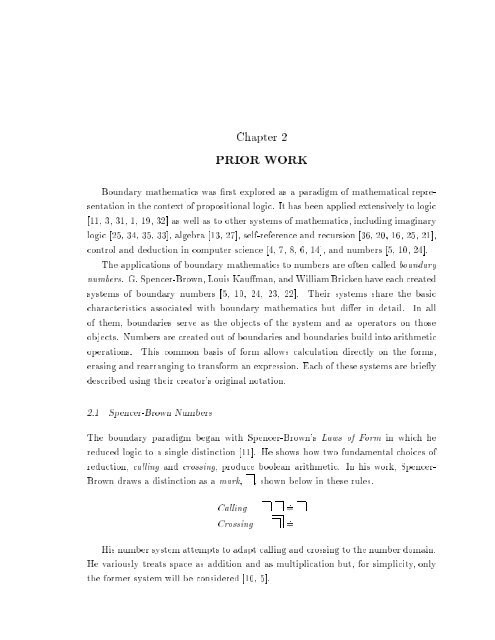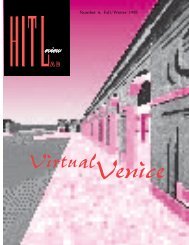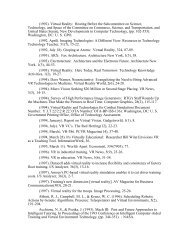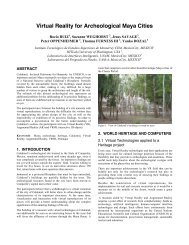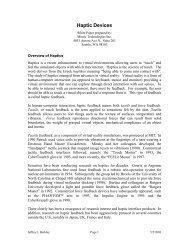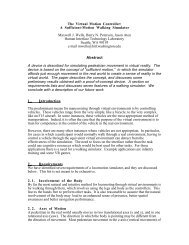A Calculus of Number Based on Spatial Forms - University of ...
A Calculus of Number Based on Spatial Forms - University of ...
A Calculus of Number Based on Spatial Forms - University of ...
You also want an ePaper? Increase the reach of your titles
YUMPU automatically turns print PDFs into web optimized ePapers that Google loves.
Chapter 2<br />
PRIOR WORK<br />
Boundary mathematics was rst explored as a paradigm <str<strong>on</strong>g>of</str<strong>on</strong>g> mathematical representati<strong>on</strong><br />
in the c<strong>on</strong>text <str<strong>on</strong>g>of</str<strong>on</strong>g> propositi<strong>on</strong>al logic. It has been applied extensively to logic<br />
[11, 3, 31, 1, 19, 32] as well as to other systems <str<strong>on</strong>g>of</str<strong>on</strong>g> mathematics, including imaginary<br />
logic [25, 34, 35, 33], algebra [13, 27], self-reference and recursi<strong>on</strong> [36, 20, 16, 25, 21],<br />
c<strong>on</strong>trol and deducti<strong>on</strong> in computer science [4, 7, 8, 6, 14], and numbers [5, 10, 24].<br />
The applicati<strong>on</strong>s <str<strong>on</strong>g>of</str<strong>on</strong>g> boundary mathematics to numbers are <str<strong>on</strong>g>of</str<strong>on</strong>g>ten called boundary<br />
numbers. G. Spencer-Brown, Louis Kauman, and William Bricken have each created<br />
systems <str<strong>on</strong>g>of</str<strong>on</strong>g> boundary numbers [5, 10, 24, 23, 22]. Their systems share the basic<br />
characteristics associated with boundary mathematics but dier in detail. In all<br />
<str<strong>on</strong>g>of</str<strong>on</strong>g> them, boundaries serve as the objects <str<strong>on</strong>g>of</str<strong>on</strong>g> the system and as operators <strong>on</strong> those<br />
objects. <str<strong>on</strong>g>Number</str<strong>on</strong>g>s are created out <str<strong>on</strong>g>of</str<strong>on</strong>g> boundaries and boundaries build into arithmetic<br />
operati<strong>on</strong>s. This comm<strong>on</strong> basis <str<strong>on</strong>g>of</str<strong>on</strong>g> form allows calculati<strong>on</strong> directly <strong>on</strong> the forms,<br />
erasing and rearranging to transform an expressi<strong>on</strong>. Each <str<strong>on</strong>g>of</str<strong>on</strong>g> these systems are briey<br />
described using their creator's original notati<strong>on</strong>.<br />
2.1 Spencer-Brown <str<strong>on</strong>g>Number</str<strong>on</strong>g>s<br />
The boundary paradigm began with Spencer-Brown's Laws <str<strong>on</strong>g>of</str<strong>on</strong>g> Form in which he<br />
reduced logic to a single distincti<strong>on</strong> [11]. He shows how two fundamental choices <str<strong>on</strong>g>of</str<strong>on</strong>g><br />
reducti<strong>on</strong>, calling and crossing, produce boolean arithmetic. In his work, Spencer-<br />
Brown draws a distincti<strong>on</strong> as a mark, , shown below in these rules.<br />
Calling<br />
Crossing<br />
:<br />
=<br />
:<br />
=<br />
His number system attempts to adapt calling and crossing to the number domain.<br />
He variously treats space as additi<strong>on</strong> and as multiplicati<strong>on</strong> but, for simplicity, <strong>on</strong>ly<br />
the former system will be c<strong>on</strong>sidered [10, 5].


